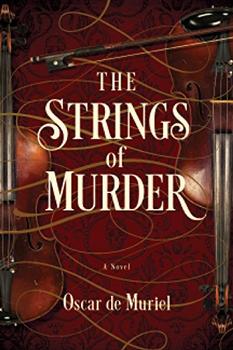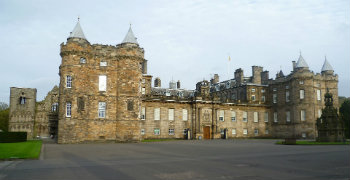Summary | Excerpt | Reviews | Beyond the Book | Read-Alikes | Genres & Themes | Author Bio

This article relates to The Strings of Murder
In The Strings of Murder, Oscar de Muriel's historical crime novel set in Victorian times, detectives, Frey and McGray crisscross a city that has been designated as a UNESCO World Heritage Site since 1995. As someone who knows Edinburgh well - I was born and grew up there - I thoroughly enjoyed the novel. Abbeyhill, opposite the famous Palace of Holyrood, was the street where I lived until I was six years old. In the book, Frey and McGray lodge in the Georgian neoclassical splendor of the Edinburgh New Town, but their suspects and crime scenes carry them up and down the High Street of the Old Town that link the famous sites of Edinburgh Castle and Holyrood Palace and Abbey.
 Edinburgh has been the capital city of Scotland since the 15th century although evidence of settlement in the area has been found dating back to the Bronze and Iron Ages. The city is formed on seven hills and the remnants of an extinct volcano. The development of the area now called the Old Town began with the fortification of one high volcanic crag — now the seat of Edinburgh Castle. Settlements grew down the original hillside ridge in a single arterial street, known as the High Street or Royal Mile, with side roads, called closes and wynds, gradually fanning out from this spine in a fishtail formation.
Edinburgh has been the capital city of Scotland since the 15th century although evidence of settlement in the area has been found dating back to the Bronze and Iron Ages. The city is formed on seven hills and the remnants of an extinct volcano. The development of the area now called the Old Town began with the fortification of one high volcanic crag — now the seat of Edinburgh Castle. Settlements grew down the original hillside ridge in a single arterial street, known as the High Street or Royal Mile, with side roads, called closes and wynds, gradually fanning out from this spine in a fishtail formation.
Edinburgh Castle has been a royal fortress since the reign of King David I in the 12th century. Protected on three sides by volcanic rock, an additional manmade safety measure was introduced by the creation of the Nor' Loch (the North Lake), most likely on the orders of James II, in the 15th century. In addition to its defensive role, the Loch was variously used as a place to test suspected witches who were declared innocent if they drowned or proved to be full of evil spirits if they floated — at which point they would be burned at the stake. The Loch was also used to dispose murder victims or criminals, and more generally as a cesspit for waste disposal for an overcrowded city. Since the 17th century, Edinburgh Castle has principally served as a military barrack. Today it is a thriving tourist attraction and home to the Edinburgh Tattoo, a military and firework display, a famous highpoint of the annual Edinburgh International Festival.
 At the other end of the spine of the Old Town, and opposite the houses on Abbey Hill where de Muriel's first murder victim is discovered, lie the Palace of Holyrood and the remains of Holyrood Abbey. The Abbey, like the Castle, dates back to the 12th century and David I. Only fragments of the Abbey now remain, as well as Queen Mary's Bath, a small garden lodge building dating back to the 16th century. The Palace of Holyrood was originally developed to provide royal accommodation. Holyrood went through a period of decline when the Scottish King James VI inherited the crown of England in 1603 and moved his court to London; it was followed by a disastrous fire in 1650. The palace was restored in the late 17th century. The current monarch, Queen Elizabeth II (Scotland and England having been united since 1707), spends one week in residence at Holyrood Palace each year.
At the other end of the spine of the Old Town, and opposite the houses on Abbey Hill where de Muriel's first murder victim is discovered, lie the Palace of Holyrood and the remains of Holyrood Abbey. The Abbey, like the Castle, dates back to the 12th century and David I. Only fragments of the Abbey now remain, as well as Queen Mary's Bath, a small garden lodge building dating back to the 16th century. The Palace of Holyrood was originally developed to provide royal accommodation. Holyrood went through a period of decline when the Scottish King James VI inherited the crown of England in 1603 and moved his court to London; it was followed by a disastrous fire in 1650. The palace was restored in the late 17th century. The current monarch, Queen Elizabeth II (Scotland and England having been united since 1707), spends one week in residence at Holyrood Palace each year.
In fascinating contrast to the organic, medieval crowded buildings that grew up between the Castle and Abbey in Edinburgh's Old Town, the New Town is recognized for its neoclassical and Georgian architecture and as an early example of municipal planning. A design competition was held in 1766 to provide a layout for modern housing on this plain and James Craig was the successful architect who proposed a grid system based on three principal roads which are extant today: Princes Street, George Street and Queen Street. In the Age of Enlightenment, the burgeoning Scottish wealthy middle classes and many of Europe's important intellectuals — including David Hume, Adam Smith and Sir Walter Scott — enjoyed the elegant squares, wide streets and private gardens that are inhabited by Frey and McGray in The Strings of Murder; and which now welcome thousands of visitors to Edinburgh every year.
Pictures of Edinburgh Castle and Palace of Holyrood by Kim Traynor
Filed under Places, Cultures & Identities
![]() This "beyond the book article" relates to The Strings of Murder. It originally ran in June 2016 and has been updated for the
May 2017 paperback edition.
Go to magazine.
This "beyond the book article" relates to The Strings of Murder. It originally ran in June 2016 and has been updated for the
May 2017 paperback edition.
Go to magazine.






Your guide toexceptional books
BookBrowse seeks out and recommends the best in contemporary fiction and nonfiction—books that not only engage and entertain but also deepen our understanding of ourselves and the world around us.